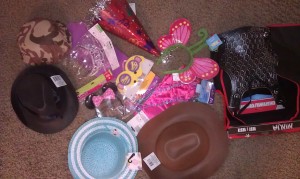Let’s Play Ball
It is amazing how much gross-motor skill children can pick up from playing with a ball. They start out not being able to catch it, than move to the stage where they catch it by trapping it up against their body with their arms. As they progress through the stages they can throw the ball, strike the ball with a large paddle or bat, and kick the ball forward by running up to it. BY the time they are in kindergarten they will begin to and then master being able to catch the ball with both hands, hit a stationary ball, bounce and catch the ball and kick the ball while they are running.
All of these stages come with exposure and repetitive playing with balls, paddle, and bats. I know this is a harder and harder thing for kids to master as our children begin to spend more and more time indoors. But it is well worth the time to take your kids outside and play ball with them. You can pick out which part of the stage they are in from the list above and work on the next part with them.
Walking On The Curb
Last year, I mentioned to my daughter that my four year old grandson needed to start practicing being able to walk on a balance beam both forward and backwards. She looked at me and said, “Really? How am I supposed to help him with that?” I actually had an easy answer for this one. Every time you’re out shopping with him, have him walk up on the curb while you hold his hand. Practice going both forwards and backwards and make it a game. It turned out to be a game he loved.
My daughter and her husband, like so many families where both parents are working, are doing a great job at trying to help their son meet every developmental milestone. But as first time parents, who are trying to squeeze as much family time as they can into every spare moment, it is hard to find the time to work on everything needed. With kids not playing outside as much as past generations, kids are not meeting these skills on their own or with their friends through play.
But don’t worry all is not lost if you haven’t worked on these skills yet! By spending just a few minutes each day running out in the yard or park, walking on curbs, skipping to the mailbox, galloping like a horse , or jumping out the letters in your name, you can help your child meet those developmental milestones quickly and with little to no effort. And your child will love the time spent being silly with you!
Have fun playing!!!
Run, Gallop And Skip
Those good old traveling skills. Something most children are great at. I can’t even put a number to the number of times I told my five children to stop running in the house, or stop jumping up and down the stairs. Little did I know how important those traveling skills they were learning with all that running around being kids would be so important to their kindergarten assessment.
But they are. If your child can move purposely from place to place, showing coordination, and using harder and harder movements, than they are right on track in their development. Some of the skills you can help them practice before they start kindergarten include:
- Running/ while avoiding other people, furniture, and items.
- Climbing up and down stairs using alternating feet
- Rides their tricycle or bike using the pedals
- Gallops and skips easily from one spot to another
- Can jump up and down
- Can change directions by stopping and starting quickly and with ease
I know these all seem like such basic skills, but I am always surprised that each year at least a couple of children cannot run or jump smoothly. And as kids spend more and more time in from of their video games or TV, these traveling skills are becoming harder and harder to accomplish. So, starting today if your child needs to work on their traveling skills, enjoy some time outside in the spring weather, practicing running, jumping and skipping together.
Taking Care of Needs
Expectations for taking care of one’s own needs will vary a little in each different classroom, but it really is the basic concept of can you take care of yourself during the school day. I don’t mean take care of yourself as in your on your own, but does your child have those basic developmentally skills that will make their life a little less frustrating while they are without you at school each day. Some of the skills that will help your child everyday at school include:
Being able to zip and button their coat. Every kindergarten classroom has different expectations for this skill. I help kids who cannot zip their jacket or have a friend help them before they go outside. But some of you are going to run into classrooms where your child is going to be going outside without their coat zipped if they cannot do it by themselves. So work on it now so your child can take care of the jackets and their pants.
- Tying shoes. The nice thing about kids shoes is if your child can not tie their own shoe by the time they start kindergarten they can wear Velcro shoes. My own sons absolutely wore Velcro in kinder. Tying shoes is a skill you can continue to work on at home but if your child can not tie before that first day of school I would suggest sending them with shoes that buckle or use Velcro.
- Wash and dry your hands. Can your child be in charge of washing and drying their own hands? This is important for lunch time and art. The district I work for does not allow hand sanitizer, just good old soap and water. So kids need to be able to wash their hands without making to big of a mess at the sink area.
- Putting things away. Practice putting things on hooks or away in cubbie like containers. In my classroom students are required to keep their coats in their backpacks whenever they are not wearing them. (It helps to prevent the spread of lice when they inevitably come around each school year). My students have to be able to get that coat into their backpack, zip it up and put it on the hook by themselves. If this is a rule in your school please practice with them beforehand.
- Takes care of personal belongings and the belongings of others. I always try to discourage students from bringing anything extra to school. It just breaks my heart when they lose it or it is stolen on a bus. But sometimes things show up anyway. Can your child take care of their stuff, understanding that they should not give it to a friend and then expect it back, do they understand not to draw on furniture or cut their own hair with the scissors, etc.
- Clean up after themselves. Can your child help clean up either with a little help or completely by themselves? Examples: putting away their crayons and scissors, closing the glue bottle when they are finished, leaving a paint bush in the pain container.
Every teacher and/or school will have their own set of standards when it comes to children taking care of themselves and their belongings. If you can find out early what those expectations will be and practice them with your child, it will make their transition into school smoother. If your child is not able to take care of their own needs please talk to your teacher and school honestly from the start. We are there to help both you and your child transition into a formal school setting. We really want to see your child succeed and enjoy their kindergarten experience.
Following Expectations
Expectations for behavior, and following or adhering to limits is a very individual skill for children depending on their personalities and the influences they have had from their families. There is no right or wrong here. Whatever is working for your family is great. That said, I do have a but to go with that statement. Your child will need to be able to adapt to classroom behavior and expectations for both the class and the school. Happily, most children have no problem meeting these expectations. The first few weeks are sometimes hard as they learn where they fit in to this new environment, but they almost always find their place to fit in and do a beautiful job of living up to the expectations.
Some conversations you may want to have with your child before they come to school can include: 1.) Remember that we have different voice levels and ideas of ways to sit and walk in class and out on the playground. 2.) Behavior at home will be different in some ways than at home. Children will need to learn how to wait their turn, not interrupt, sit still for periods of time and work as a group rather than as an individual. 3.) Teachers will expect children to move along with activities and transitions. There is always so much to do in a day and never enough time to get it all done.
That all said, please remember we know this is your childs first time in an elementary school setting. We do not expect them to be able to rise up to every occasion beginning on the very first day. Kindergarten has a huge learning curve for little ones. I am always amazed at how much they have grown in just the first month.
Ideas for you to try at home: Show your child different ways you will expect them to act at school and how they differ from home, a restaurant, the park, a store, etc… Take them to your local Libraries children’s program. They can practice sitting, listening and sharing with other kids while listening to great stories. Talk to your child about the behaviors they are likely to be expected to use at school (especially sharing, asking for help from an adult, the difference between tattling and getting help when you have a problem. ( I always tell my kids they need to come to me or another adult at the school immediately if someone is hurting them with either their body or their words). And finally make sure your child knows that there is an open line of communication between yourself and the teacher. That way, students are not surprised when they find out you know they did not meet the expectations at school that day, but it also means that you and the teacher are a team working together for their best education.
I love beginning a part of a families team in education, and so will your childs teacher.
Skills For Kindergarten
When I sent my first child to Kindergarten many, many years ago, it never crossed my mind what types of developmental skills he had or didn’t have that a teacher would be looking at. I mean, he could read, knew his colors and shapes, and could count. What else could there be? When that same wonderful child was in high school I became a teacher and found out there was a world of skills and experiences that his kindergarten teacher was introducing him to in school that I didn’t ever think of. Don’t get me wrong, my child was top of his class, and had picked up all the skills he needed naturally through play and talking with his family but it wasn’t anything I had taught him. It was just us going along and like all of you, trying the best we could. But in the 25 years since I sent my first child off to school, many, many thing have changed in education. First of all, school is much harder for today’s students than it was for my own. The common core standards have pushed harder skills down towards our lower grades. Can the students live up to these standards? Absolutely, but not on their own. They need guidance and direct teaching both from the school and at home. For the most part, we kindergarten teachers have found that the students that succeed in school now a days come to us with a huge bag of skills on their first day of school.
As a parent in today’s society, I know that you would love to know all of the things a kindergarten teacher is looking for before you take your child to the kindergarten screening required of the school district in august. By the time August comes around and you find out what your child needs to work on there isn’t enough time left to teach it to them before the first day of school. The school districts of my state look not only at reading and math but at social emotional, physical, and cognitive skills and a childs language abilities. I am going to give each of you an inside view of what I look for each August as a student comes to the kindergarten screening. As well as some small, fun activities that you can do with your kids to help them build their skills before that first day in August.
Remember, any skills your child brings with them on that first day is a wonderful gift you have given them and the more they bring the better they will succeed.
Kindergarten: To Go Or Not To Go
This question is a huge issue for both families and schools. Every year as I meet with my future Kindergarten students and their parents at least one family will tell me they are concerned about whether or not their child is truly ready to come to school. And then they ask “What do you think?” This is not an easy question to answer. In fact there really isn’t one great answer to give. It all boils down to what everyone involved in the child’s education can agree on. That being said, here are a few suggestions I have that I hope will help you with your decision on whether or not to send your child to Kindergarten this year.
First and most importantly follow your instincts on this subject. You know your child better than anyone else. You know if they can handle social situations, being away from you for the day while having to show lots of independence and continue to grow that independence throughout the year and how they learn. If you feel your child is well rounded socially, can handle the new CCSS curriculums and the rigor that comes with them and your child is excited to come to school, please send them.
If you are questioning if you should send your child or not, than your instincts are telling you something. Here are some suggestions we give to parents. 1). Hang in there you still have 5 months until Kindergarten starts. Try out different social situations while working with your child to help them grow a little more independence. 2.) Consider holding your child one more year before you send them to kindergarten. I have met many parents who regretted sending their children too early; I have never met one who regretted keeping their child at home for one more year. 3.) Consider doing a year in preschool, if your child has not previously been involved in a preschool program. Or do another year if they are currently enrolled in preschool. 4.) Ask if your school has a red shirt program. Red shirt programs allow your child to do Kindergarten twice. Giving them that extra year before they jump into first grade. 5.) Keep your child home for one more year. My own grandson stayed out a year and will be starting this fall. It turned out to be a wonderful gift to him to do preschool again this year. 6.) Talk to the kindergarten teacher before school starts. If they feel your child is not ready for the kindergarten experience find out why and how you can help. Remember these teachers have a lot of experience with children that have both succeeded and not succeeded. They are trying to help your child have a great kindergarten year and it’s not a personal jab at you if your child needs more time to get ready for school. They are there to help your child have the best first year in school experience ever, glean their knowledge and use it to help you make your decision.
The most important thing is to remember once you make up your mind, stick to your decision. It is a great choice. What your friends kids or preschool kids you know do is of no concern to your child’s education and whether you made the right choice or not. You are your child’s best advocate. If you are choosing to send your child to school this coming fall, I hope they will have a wonderful year. If you are choosing to keep them home one more year I hope you enjoy your extra time with your little one at home.
Let’s Get Ready For Kindergarten!
So it’s the end of March and my first thought every year around this time is how can I help parents make sure their kids are ready for Kindergarten before the school district screening in August? My district has always assessed and met with the parents and in coming Kindergarten students each year to go over what their child is good at and where they have needs for growth. But let’s face it, August is a little late to be hearing about the things your child needs to be working on. Reality is Kindergarten starts two weeks after the assessments. So I have been kicking around the idea of doing some short blogs for parents on making sure your child has what they need to be successful and give you some time to work on some basic skills. As I thought more and more about what I could write about, I realized I should divide my ideas into three basic groups. First, basic kindergarten skills that every child should be working on or already know to be successful. Secondly, things parents can do to make their partnership with the school and teachers easier for the students and their families. And lastly, how to unpack the CCSS standards at a kindergarten level so every family knows what to expect for the school year and how to help their child achieve their goals.
And so starts my first set of blogs. What every child needs to know before they leave kindergarten. Notice the big leave in dark, bold type. Please don’t read this and think, “We are behind!!! What are we going to do?” My goal as a kindergarten teacher has always been to take your child from where they are on that first day of school and work with them to make sure they can master all of these developmental goals before they leave me. Is every child successful? No! I would be lying to you if I said they were. But these are my goals none-the-less. My little kiddos work hard at trying to accomplish their goals each year.
The bottom line with these goals though, is the closer your child is to each of these goals, directly ties to the success they are going to have not only throughout Kindergarten but throughout their education. Starting out with any kind of educational deficit is a frustrating struggle to a student. And the honest truth is the more they have in their bag of educational knowledge before they come into my classroom, the more successful they will be. I hope my blogs over the next few weeks will help you to better understand what kindergarten teachers are looking for in an incoming student, give you resources to work with your child in a fun, non-classroom style of learning and make you feel confident in your child’s abilities to succeed in their first elementary school setting.
So, Let’s Get Ready For Kindergarten!
Daily News
Every year I seem to change how I do the daily news. When I moved into Kindergarten from First grade six years ago, I had the kids tell me a narrative that I would write up for them as the daily news. I noticed this was a great way to teach narrative and small moment but my students didn’t seem to be able to grab on to the concepts that are the mechanics of writing. I know, I know those dreaded capital letters, periods, etc… Developmentally that seemed so hard for them. So through the years I have been trying to find a happy balance to introduce them both to new writing genres and the mechanics of writing. This year I have added sounds and a hand motion for punctuation when we reread. I have also changed what we o with the daily news piece each morning when we finish it. Here are a few examples of ideas I have used during Daily news.
In this example from the beginning of the school year. We work on beginning sounds and the letters they make the sound. I randomly pick letters to underline and make the sound with them from the Daily news each morning. We also talk about the number of the day, which is always the day part of the date.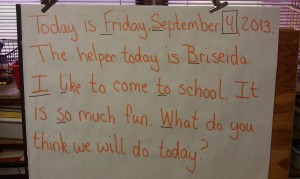
The second example begins during the second quarter of the school year. I circle ten or so sight words that we have bee working on and then we read then as a whole group. I always include the date as well. 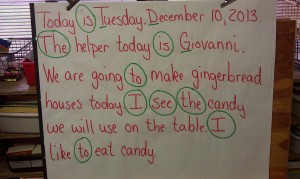
The Third example begins third quarter ( do you see my pattern here. haha) I have the helper each morning pick ten students one at a time. The student that is picked reads a sight word off of the daily news. The helper then finds the word on the page and circles it.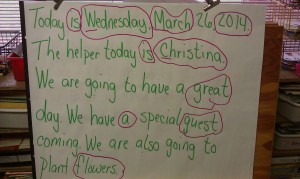
The fourth example, fourth quarter of course, becomes a team effort to write the daily news. I write part of the words with my color of marker and the helper of the day writes their part with another color. I try not to have as long of sentences this time of year because it takes the students longer to write their part. I say the sentence we are going to write out loud, count the number of words we will be writing on our fingers and then go over it with the whole group before we start each sentence.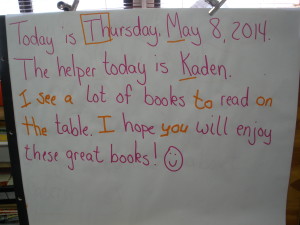
At the end of every daily news, we always reread the entire page as a whole group. And we include the sound and hand motion for each different part of the punctuation in the piece.
I would love to hear from all of you! I love getting new ideas on how to make the daily news a more effective teaching moment. Please share your ideas!!! Have a great Saturday!!!
End Of The Year Door Decorations
Every month I change the decorations on my classroom door to match something that is going on that month. I usually use holidays or seasons and always the kids names. But for the last month this year I am going to try something new. I went to the dollar store and bought all kinds of hats, glasses, etc. to dress-up with. I am planning to have each of my kids dress up how ever they want, hold a sign up that states what they want to be when they grow up and take their picture. I am going to hang their pictures on the door under the statement “Class of 2026!” I am so excited to see it, yet dismayed that the year 2026 seems like forever! And I got a shopping trip to the dollar store out of this new idea, which always makes for a great day! Have a wonderful Saturday!!! 🙂 (Here are some of my dollar store finds!)
